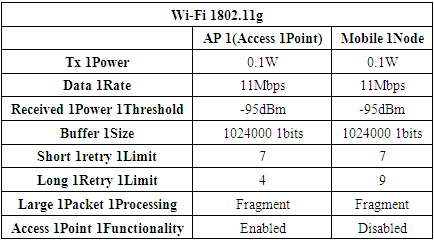-
Paper Information
- Paper Submission
-
Journal Information
- About This Journal
- Editorial Board
- Current Issue
- Archive
- Author Guidelines
- Contact Us
Journal of Wireless Networking and Communications
p-ISSN: 2167-7328 e-ISSN: 2167-7336
2022; 11(1): 1-10
doi:10.5923/j.jwnc.20221101.01
Received: Oct. 13, 2022; Accepted: Oct. 24, 2022; Published: Nov. 14, 2022

Performance Evaluation and Compression of IP Packets in a Wireless Local Area Network (WLAN)
Bernard Sentala , Charles S. Lubobya , Ackim Zulu
Department of Electrical Engineering, University of Zambia, School of Engineering, Lusaka, Zambia
Correspondence to: Bernard Sentala , Department of Electrical Engineering, University of Zambia, School of Engineering, Lusaka, Zambia.
| Email: |  |
Copyright © 2022 The Author(s). Published by Scientific & Academic Publishing.
This work is licensed under the Creative Commons Attribution International License (CC BY).
http://creativecommons.org/licenses/by/4.0/

The study focuses on the Performance Evaluation and Compression of IP Packets in a Wireless Local Area Network (WLAN). WLAN has many network challenges such as network delay, buffering requirement, bandwidth, and network congestion. The aim of the study is to design and develop a WLAN model that would assist test the Performance Evaluation and Compression of IP Packets in a WLAN. The key specific objectives are to assess the effectiveness and efficiency of per-interface compression in a WLAN during IP packet transmission; to analyze the effects of TCP/IP header compression and per-virtual circuit compression on performance and/or quality of service (QoS) in a WLAN, and to design and develop the best compression scheme in transmitting IP Packets in a WLAN. OPNET simulation software tool has been used to simulate the four (4) IP Packet Compression Schemes that include; No compression, Per-interface Compression, TCP/IP Header Compression, and Per-virtual Circuit Compression. The results indicate that Per-virtual Circuit Compression Scheme performed below Per-Interface and TCP/IP Header Compression Schemes. No Compression Scheme is utilized solely for comparative reasons and the scheme recorded the lowest score of all the compression schemes. In terms of overall performance, the Per-Interface Compression algorithm excelled over all other compression schemes tested in the study.
Keywords: Compression, OPNET, WLAN, Efficiency, and performance
Cite this paper: Bernard Sentala , Charles S. Lubobya , Ackim Zulu , Performance Evaluation and Compression of IP Packets in a Wireless Local Area Network (WLAN), Journal of Wireless Networking and Communications, Vol. 11 No. 1, 2022, pp. 1-10. doi: 10.5923/j.jwnc.20221101.01.
Article Outline
1. Introduction
- In general, IP packet compression is the process that reduces the packet size or file size of digital signals without changing the amount of digital file signals during data transmission without affecting the signal amount of digital files in a Wireless Local Area Network (WLAN) [1] [2]. To simulate and come up with a better solution, the study employed Optimized Network Engineering Tool (OPNET) software for computer network simulation, modeling, and analysis. This was done in order to create optimized and/or mitigated IP Packet delivery challenges, the study aim was to design and develop a model that would help in testing the Performance Evaluation and Compression of IP Packets in a Wireless Local Area Network (WLAN) using four (4) compression schemes while taking performance and Quality of Service into consideration. The key specific objectives were: to assess the effectiveness and efficiency of the per-interface compression in a WLAN during IP packet transmission; to analyze the effects of TCP/IP header and per-virtual circuit compression on performance and/or quality of service (QoS) in a WLAN, and to design and develop the best compression scheme in transmitting IP Packets in a WLAN. The network problems such as Queuing, transmission, propagation, and processing delays, including buffering needs and network congestion of IP packets, could be reduced and/ or mitigated when the available resources are employed as efficiently and effectively as possible [1] [2] [3] [4].The study focused on the Performance Evaluation and Compression of IP Packets in a Wireless Local Area Network (WLAN) as a strategy to optimize and reduce packet network delay problems in connection with IP Packet delivery [2]. Data compression is a coding system that allows characters to be eliminated from data frames on the sending side of a transmission device and appropriately substituted on the receiving side [3]. Compression is classified into two (2) major categories: lossy and lossless. Lossy compression occurs when data is compressed to reduce the file size by permanently deleting unnecessary information, such as a picture, and image quality is lowered to a minimum. A lossless compression system is one in which X and Y are identical, whereas a lossy compression technique gives substantially better compression than lossless compression but enables Y to diverge from X [3] [4] [5]. The study found that the Per-Virtual Circuit Compression technique continuously trailed behind the Per-Interface Compression and TCP/IP header compression schemes. None, no compression scheme is used merely for comparison purposes, and this scheme obtained the lowest score of all the compression schemes tested. The per-interface compression Scheme has provided the best performance and good quality of service during the study.The paper is therefore, organized through sections consisting of the following headings: introduction, related work, data compression, research methodology, results and discussion, and conclusion.
2. Related Work
- Compressing and decompressing of data files for storage is basically the same as sending and receiving compressed data. IP packet compression in Wireless Local Area Network (WLAN) and other networks such as mobile ad hoc networks (MANETs) and satellites have received a lot of attention in the recent past. This section gives a review of related works on data compression schemes.According to Cha, Hyejin, et al. [6], audio and video packets are sent through IP, UDP, and RTP across a streaming media network. Inefficient data transmission might result from redundant header data on continually sent packets. The Robust Header Compression (RoHC) method was employed to prevent redundancy header data that could be detected. It employed Window Least Significant Bit (WLSB), an encoding technique that makes advantage of the window offset value. The research developed an adaptive approach for adjusting the window shift value when sending RTP packets. According to the findings, the window shift value is changed based on the amount of packet losses. The suggested method's experimental findings show that as the window shift value is changed, the header compression ratios rise and the average header size decreases. The redundancy detected in individual packet headers and subsequent packets belonging to the same IP flow determines the reduction in protocol overhead [6].Mate Tomoskozi et al. [7], states that the 5th Generation (5G) mesh networks may have protocol encapsulation overhead that surpasses the amount of data to be provided. One way, according to the study, would be to use header compression technologies to reduce the size of individual protocol headers. Robust Header Compression (RoHC) is a well-established standard that properly handles IP-based compression. Because compression functions on a peer-to-peer, single-hop basis, the existing approach at the time of the study did not allow for the installation of wireless mesh networks. The study indicates that payload delivery overhead for RTP transmissions could be cut in half even when a standard like RoHCv2 has difficulties and may fail to compress the IP packet. The study only examined RTP transport; hence the results may differ in TCP and UDP transport scenarios done under WLAN platform [7].Matias and Refua [8], argues that data compression for IP Packet networks, is transmitted by partitioning it into IP Packets. IP Packet Compression allows better bandwidth utilization of a communication line resulting in much smaller amounts of the packet drops, more simultaneous sessions, and smooth behaviour of applications. IP Packet Compression can be obtained by a combination of header compression and payload compression, which are complementary methods. However, the study does not suggest or recommend the use of other compression schemes such as Per-Interface compression as the approach for optimisation that can be undertaken in a WLAN platform [8].Carlos Feres [9], argues that Robust Header Compression (RoHC) is used in packet-switched wireless networks such as 4G and 5G cellular systems to reduce Packet Data Convergence Protocol (PDCP) header length and improve payload efficiency. Recent works on RoHC control based on a Partially Observable Markov Decision Process (POMDP) formulation has emphasized the need for employing a trans-layer strategy that makes use of lower layer information. The POMDP approach has the advantage of reducing the computational complexity of traditional RoHC. The study emphasizes simplicity by building RoHC compressors using lower layer information, such as channel adaptive transport block size due to link adaptation, which is typical in many wireless networks. The model was directly aimed at practical implementation and can achieve transmission efficiency equivalent to optimal POMDP compression [9]. Lubobya et al. [10], investigated the computation time of Single Input Multiple Data (SIMD) when compressing static video packets (or datagrams) on a stand-alone personal computer. In their study, they achieved SIMD computation time increases of 14,000ms and 17,000ms for pairs of Integer DCT and Hadamard transforms, which were limited to static video that was compressed without sending the video over a Wireless Local Area Network (WLAN) [10].In this study, we evaluated the comparative compression of video conferencing by simulating four (4) compression algorithms using the Optimized Network Engineering Tool (OPNET) software to assess the performance evaluation and compression of IP packets in a full-function WLAN platform.
3. Data Compression
- The increasing expansion of data in the digital age has necessitated the development of effective data compression solutions. Data compression, in general, originally occurred in the early nineteenth century. Data compression techniques result in more efficient use of available storage space and bandwidth, which improves performance and throughput during packet delivery. Data compression is the process of decreasing the amount of data into a smaller yet more compact form. Compression is the process of transforming a set of data into a code in order to reduce the demand for data storage and transmission speed [5] [11]. Data compression entails identifying models for the many different sorts of structures found in various forms of data. These might take the shape of patterns that can be identified simply by changing the data, or statistical structures that need a more sophisticated approach [12]. Data compression is essential because uncompressed data takes up a lot of space, reducing the effectiveness and efficiency of CPU power owing to the restricted hard drive space available. Compression provides benefits such as reduced resource utilization and cost [11] [12]. Lossless and lossy compression techniques are the most common types of compression algorithms. Text data, for example, is represented in a compact form through lossless data compression. Lossy data compression allows for data loss during the compression process. Due to human ears senses that are imprecise, certain tones in compressed audio data are not perceptible. Huffman, Lempel Ziv Welch, and Run Length Encoding are examples of compression algorithm approaches [11] [12] [13]. Below is Figure 1. Lossless and Lossy Compression [14].
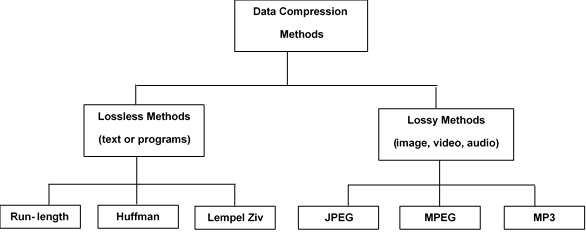 | Figure 1. Lossless and Lossy Compression [14] |
3.1. Packet Compression Techniques
- The recent appearance and popularity of the wireless internet have created a desire for increased transmission efficiency, particularly if the link has a high cost of communication bytes. IP Packet compression at the connection layer may speed up delivery and make better use of available bandwidth capacity. IP Packet compression can be configured to compress simply the header, only the payload, or both sections of the packet. There are numerous approaches for compressing IP packets, that may include stateless and stateful compression, lossless and lossy compression, and header compression. There are several techniques for compressing IP Packets that are indicated below in Figure 2. compression techniques [15].
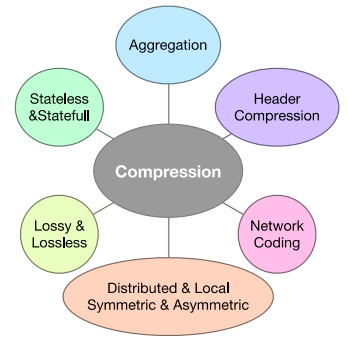 | Figure 2. Compression techniques [15] |
3.1.1. Stateless and Stateful
- When using stateless compression, packets are compressed and decompressed separately, with no reference to any other packet. When packets come out of order at the receiving end, the compression and decompression strategy is advantageous. Stateless meaning that it compresses any pieces of data it encounters without relying on past inputs [16].Stateful compression processes are those that do not yet have access to memory but utilize it to make choices. There would always be a discussion between the sender and the receiver in the case of stateful compression. During the transmission, both sides agree on the semantics of the compression [12].When using stateless compression, packets are compressed and decompressed separately, with no reference to one other. Since there is no need to presume anything before the negotiation, the stateful technique would allow for significantly higher compression rates than the stateless approach. Due to the nature of wireless communication, some packet loss and bit mistakes are unavoidable; nonetheless, if the losses and errors are extremely minimal, the stateless technique outperforms the stateful approach [12]. Data Compression methods can be divided into lossy and lossless techniques.
3.1.2. Lossless Techniques
- The goal of the lossless approach is to return the original data. This approach may be used to compress data such as text or programmes, but it can also compress picture and video data. There are several lossless approaches or techniques, which include:Run Length Encoding: RLE is a fundamental data compression algorithm that is supported by bitmap file formats such as bitmap picture files (BMP). RLE compresses data by reducing the physical size of a repeated string of letters. It can also be combined with other compression methods [17].Lempel-Ziv-Welch (LZW): The LZW is a general-purpose compression method that can handle practically any sort of data. It substitutes the real data with references to a database of strings that are often found in the data being compressed. The table is created during compression when the data is encoded and decoded [17].Huffman Coding: Huffman coding is used to compress data containing American Standard Code for Information Interchange (ASCII) characters. It is used to compress several sorts of data, including text, audio, video, and images. This approach is based on creating a complete binary tree for all of the symbols in the original file [18].
3.2. Lossy Techniques
- Lossy compression differs from lossless compression in that some data may be lost throughout the process, as the term suggests. Lossy compression methods are commonly employed to compress data that originated as analog signals, such as voice, video, images, and music files that may be cut at the margins. Pictures, unlike text and processing files, do not require reconstruction to be identical to the original, especially if the data lost is minor or undetected. Lossy compression might be used in the video, picture, and audio/voice applications. JPEG, MP3, and MPEG are the most common lossy compression-based picture formats, and the many approaches used include Chroma subsampling, colour reduction, fractal compression, transform coding, vector quantization, and many more [17].
3.3. Header Compression
- A network packet is a packet that comprises data and header information from several protocols. The header section is noteworthy because it contains duplicate information about distinct protocol headers, particularly across consecutive packets belonging to the same flow. This type of redundant data can be omitted, combined, or eliminated. Not all of that information is required over a single link, and some of it can be deleted temporarily [18].
4. Research Methodology
- This section dealt with research procedures for gathering data, variables involved, an explanation of how data was analysed and any other information that may be required to efficaciously achieve the aim and objectives of the study. The data gathering instrument tool employed during the study was the Optimized Network Engineering (OPNET) Tool Modeler 14.5 Release, which were designed to answer the key questions of the research. The data obtained were exported to Microsoft Excel for analysis and presentation of the results that was collected from the simulations. During simulation, the metrics measured were throughput, Data dropped, Delay, Load, Network Load, Traffic sent and Media Access Delay that are supported by OPNET simulation software tool. The OPNET Modeler simulator was chosen because it supports the four (4) IP Packet Compression algorithms via its IP Attribute Config object, which accepts just one of the four (4) values: i) None (no compression), ii) TCP/IP Header Compression (just the TCP/IP header is compressed), iii) Per-Interface Compression (the complete packet is compressed), and iv) Per-Virtual Circuit Compression (only the packet's payload, not the header information is compressed). Simulations were undertaken for all the four (4) scenarios that the study had planned to undertake.
4.1. Research Methodology Process
- In this sub-section, the strategy was to describe a general plan about how the researcher intended to answer the key questions relating to the study. The study undertook four (4) scenarios as indicated below in Figure 3., to determine its performance in terms of Effectiveness and Efficiency. The results of the research were then analysed, validated, and documented. The model was developed using the following process shown in Figure 3. Research Methodology Process.
 | Figure 3. Research Methodology Process |
4.2. Network System Design
- The Network Topology implementation of the Wireless Local Area Networks (WLAN) was done by designing the network that included the Server, Access Point (AP), IP-Cloud, Gateway Router (Ethernet4_slip_gtwy), Seven (7) Wireless Workstations, Applications, Profiles, Task and IP Attribute Config object as shown in Figure 2. WLAN Topology. The 100base-T cable was used to connect the devices from Access Point (AP) to the Gateway router and from Gateway router to the IP cloud PPP_DS3 was used. Similarly, from IP Cloud to PPP Server, PPP_DS3 cable was used. It is important to note that the 100Base-T link represents an Ethernet connection operating at 100Mbps (i.e. 10 times faster than standard Ethernet). The Basic Service Set Identifier (BSSID) was set to 1 for all the nodes and Access Point (AP). The BSSID is the Media Access Control (MAC) physical address of the Access Point or wireless router which was used to connect to the Wi-Fi and that the term is used in wireless network. The Basic Service Set (BSS) is the cornerstone topology of any 802.11 network. Below is Figure 4. WLAN Topology.
 | Figure 4. WLAN Topology |
4.3. OPNET
- For the purpose of this study, OPNET simulator tool is used as it supports IP Packet Compression through the IP Compression Information Attribute in the IP Attribute Config object. By default, the IP Compression Information attribute in OPNET contains a set of pre-configured compression schemes that include; None no compression, TCP/IP header compression, per-interface compression, per virtual circuit compression, image compression, and Telnet application compression [3].
4.3.1. Simulation Setup
- In this study, the access point and mobile node settings were configured as given in table 1.
|
|
5. Results and Discussion
- In this subsection, the study shows and analyzes the results of OPNET simulations performed using the approach provided earlier under the subtitle Research Methodology. The researcher ran OPNET simulations over a simulated WLAN using four (4) compression schemes: i) none, no compression, ii) compression at the interface, the entire packet compressed, iii) TCP/IP header compression, only the TCP/IP header is compressed, and iv) Per-Virtual Circuit Compression, only the packet payload is compressed. Each compression strategy was performed as a scenario, with seven (7) clients/users, a time of 1200 seconds, and a data rate of 11 Mbps was considered.The following stage was to evaluate the performance and Quality of Service of all compression techniques using measurable metrics such as throughput, data lost, traffic sent, and media access latency. These measures are decisive in terms of overall performance and quality of service. The obtained data were exported to Microsoft Excel for additional analysis and comparative discussion using graphs.
5.1. Throughput
- The number of information bits successfully delivered or received per second is known as throughput [19]. It indicates how much data can be moved from one point to another in a given length of time across a network. Network throughput monitors wireless media and wireless bandwidth usage, which is a finite resource in a network, hence making the best use of these resources is vital. The study examined the throughput graphs for the four (4) compression schemes. Figure 5. depicts the results of the IP packet compression approaches obtained from the OPNET simulation. The x-axis (horizontal) represents time, whereas the labels on the y-bar denote throughput (vertical) bits per second.In Figure 5., we observed that the time needed to establish a WLAN connection was from 0 to 96 seconds, after which the graphs for all compression algorithms began to rise. According to the results, the time for the Per-Interface compression graph increased from 96 to 108 seconds, and the throughput increased from 0 to 432925 bits per second. The time for None no compression graph increased from 96 to 108 seconds and throughput from 0 to 1873536 bits per second. The time for the Per-Virtual Circuit compression graph increased from 96 to 108 seconds, and throughput from 0 to 1873536 bits per second. While the time for TCP/IP header compression graph increased from 96 to 120 seconds and throughput from 0 to 4031784 bits per second.
 | Figure 5. Throughput (bits/sec) |
5.2. Data dropped (Packet Loss)
- The Data dropped is the total amount of bits sent by a wireless node but never received by the other node due to reasons such as network congestion and delay, router problems, network congestion queues, and the longer the packet travels, the greater the probability of data loss [20]. It might also be due to a lack of media access, which has a significant impact on WLAN dependability. The study compared the Data dropped graphs for the four (4) compression techniques evaluated. The results of the IP packet compression techniques acquired from the OPNET simulation are shown in Figure 6. below. The x-axis (horizontal) represents time in seconds, while the labels on the y-bar (vertical) reflect data decrease in bits per second.
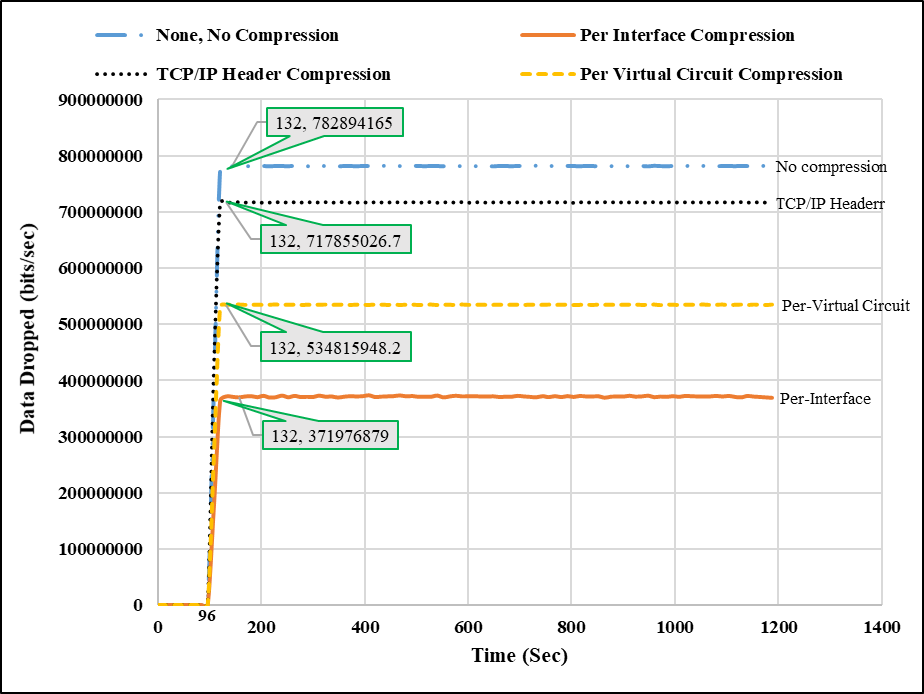 | Figure 6. Data dropped (bits/sec) |
5.3. Traffic Sent
- Traffic sent, also known as network traffic or data traffic, refers to the volume of data moving across a computer network at any given time [21]. The study compared Traffic Sent for the four (4) compression schemes evaluated. The results of the IP packet compression schemes acquired from the OPNET simulation are shown below in Figure 7. Time is shown on the x-axis (horizontal), while the labels on the y-bar (vertical) signify Traffic Sent in bytes per second.
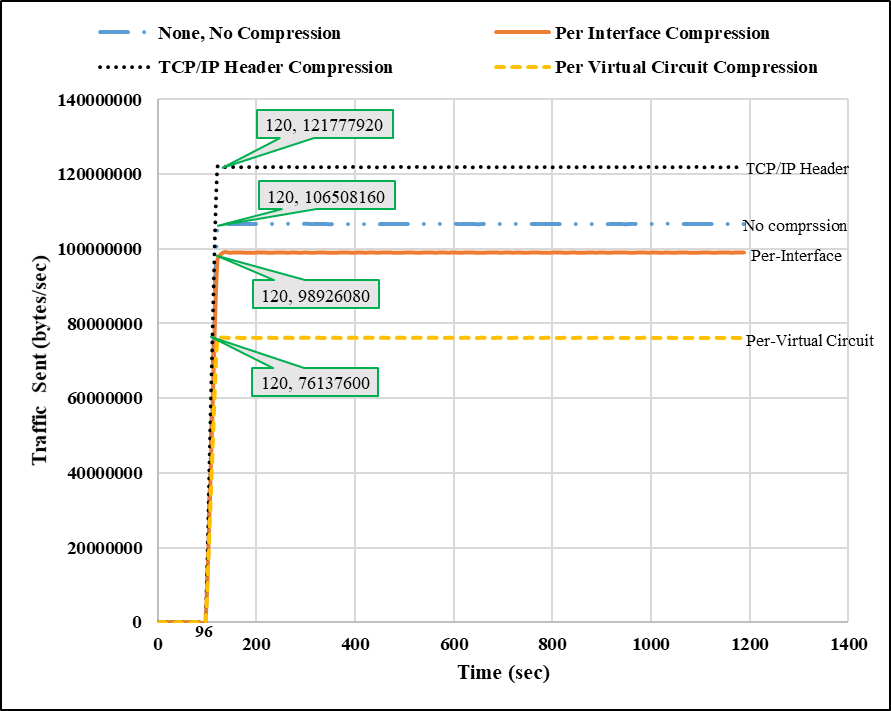 | Figure 7. Traffic Sent (bytes/sec) |
5.4. Media Access Delay
- Media access delay is the amount of time it takes for data to reach the media access control (MAC) layer and be successfully sent to the network's WLAN interface [21]. The entire amount of queuing time and data packet delay necessary for a signal head to access the medium is referred to as media access delay. The study compared the media access latency of the four (4) compression techniques evaluated. Figure 8. shows the OPNET simulation results for IP packet compression techniques. We have time in seconds on the x-axis (horizontal), and the labels on the y-bar (vertical) shows the media access latency in bits per second.
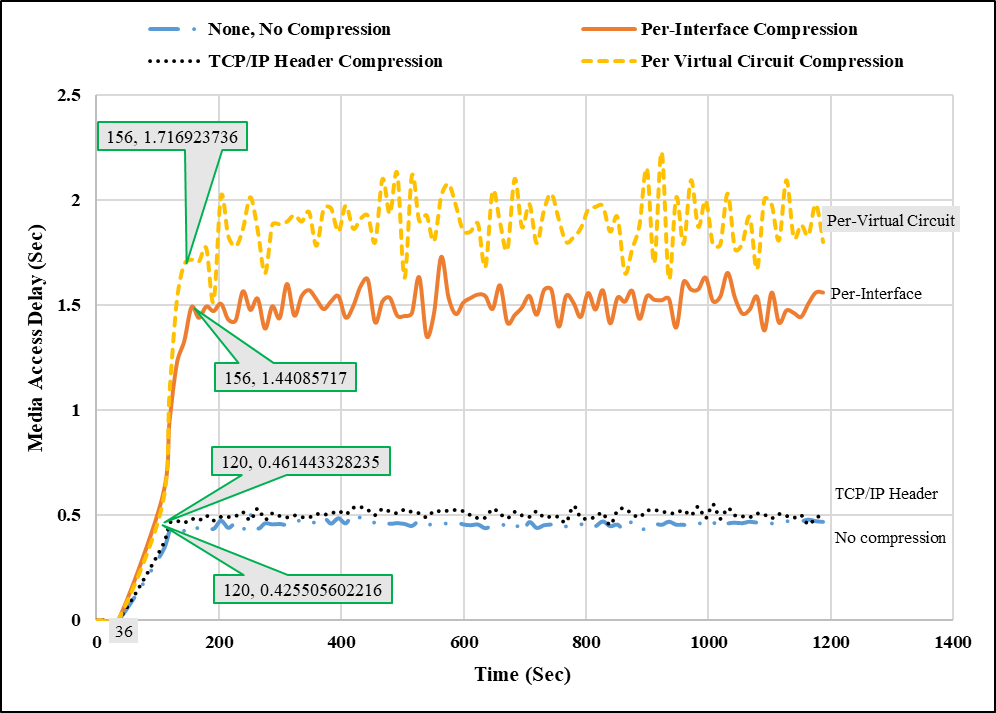 | Figure 8. Media access Delay (sec) |
6. Conclusions
- The scope and objective of the study were to design and develop a model that would help in examining the Performance Evaluation and Compression of IP Packets in a Wireless Local Area Network (WLAN) using four (4) methods in the transmission of a high bandwidth application, such as video conferencing. The study undertook several performance tests for each of the four (4) compression schemes, and measured performance metrics that include; throughput, data dropped, traffic sent, and media access delay. The simulation results show that Per-Interface compression and TCP/IP header compression outperformed all of the other compression schemes depending on the circumstances and conditions set. In contrast, per-virtual circuit compression had lagged behind Per-Interface and TCP/IP header compression schemes. In terms of overall performance under the used simulation conditions in this particular study of performance of WLAN, Per-Interface Compression Scheme had the best performance and good Quality of Service. It is therefore, important to state that the work given in this study lays the groundwork, yet there is still potential for improvement. As a result, it is evident that similar or more study could be conducted to explore more simulation situations comparable to a larger network real-life scenario to determine if the same findings could be established.
 Abstract
Abstract Reference
Reference Full-Text PDF
Full-Text PDF Full-text HTML
Full-text HTML